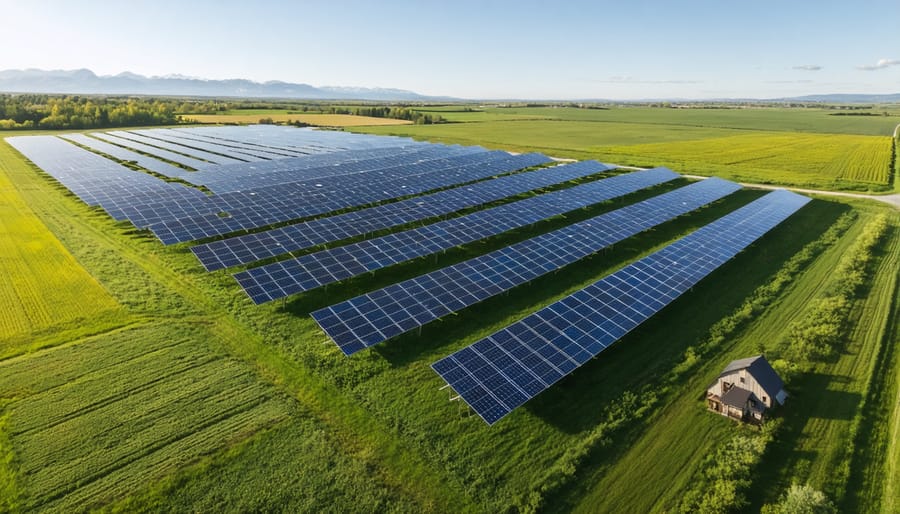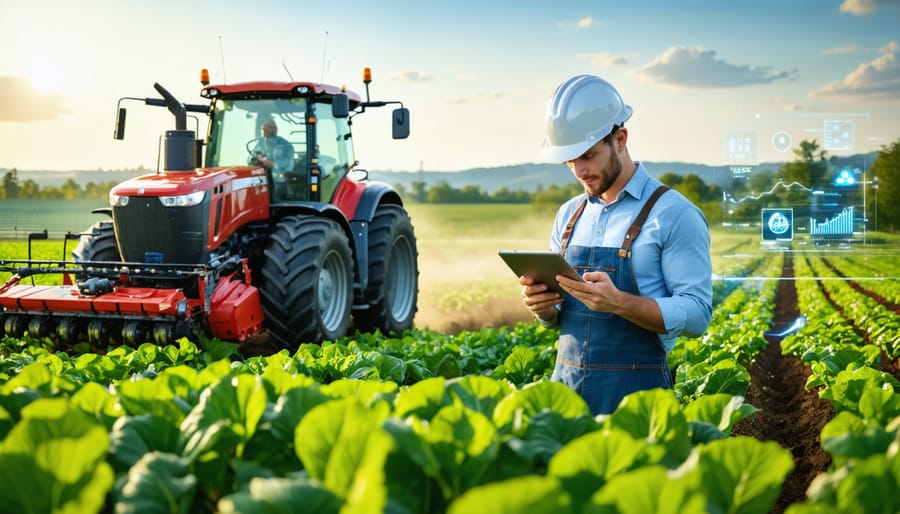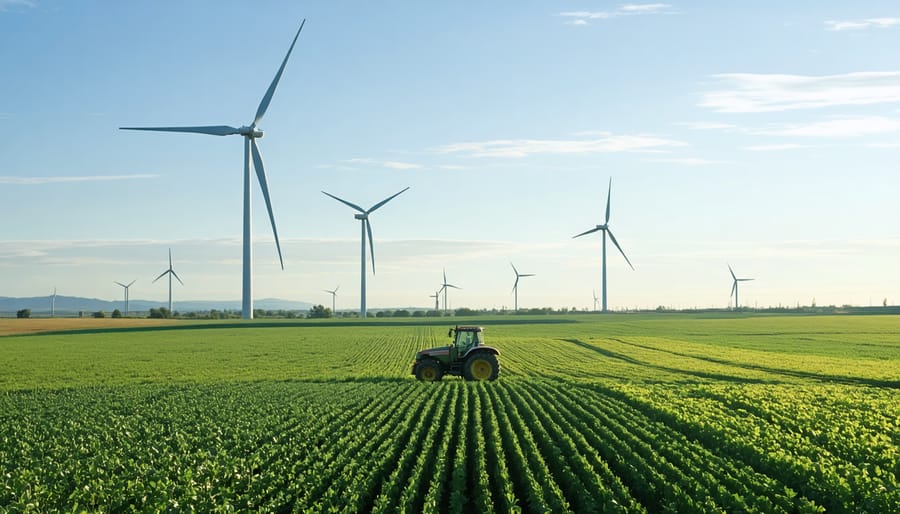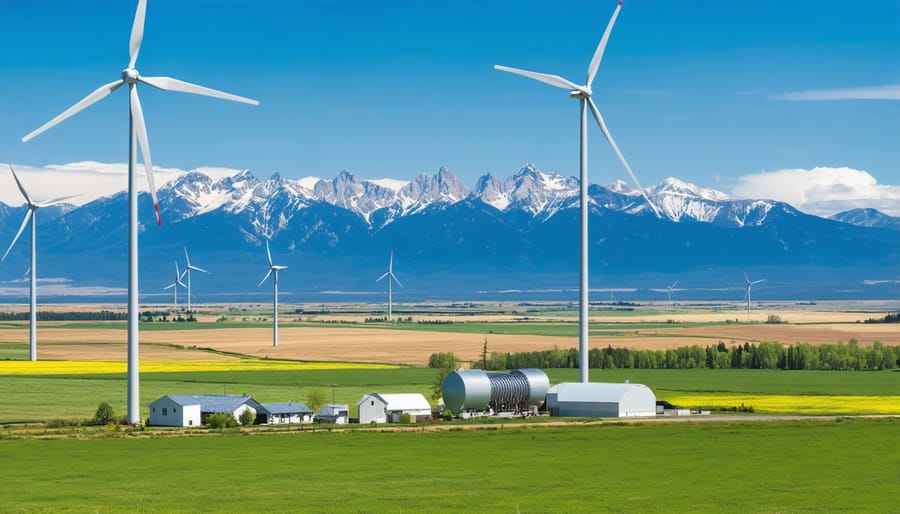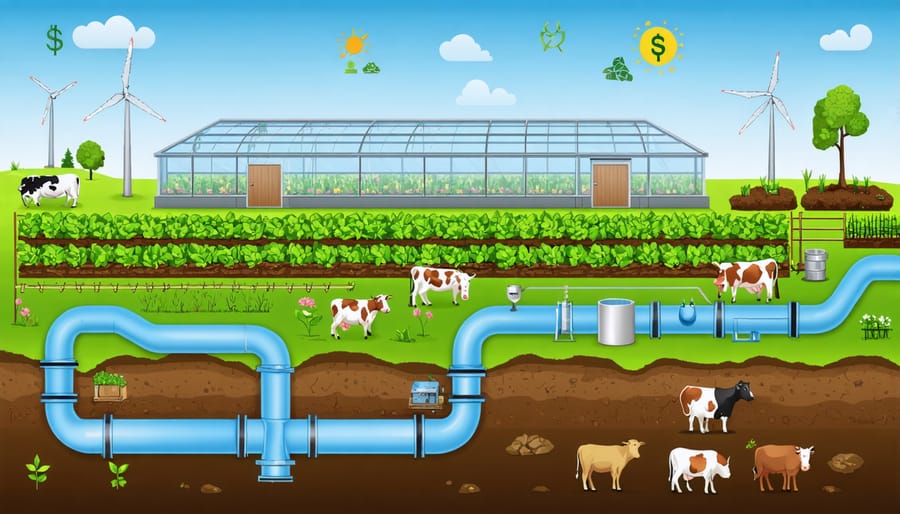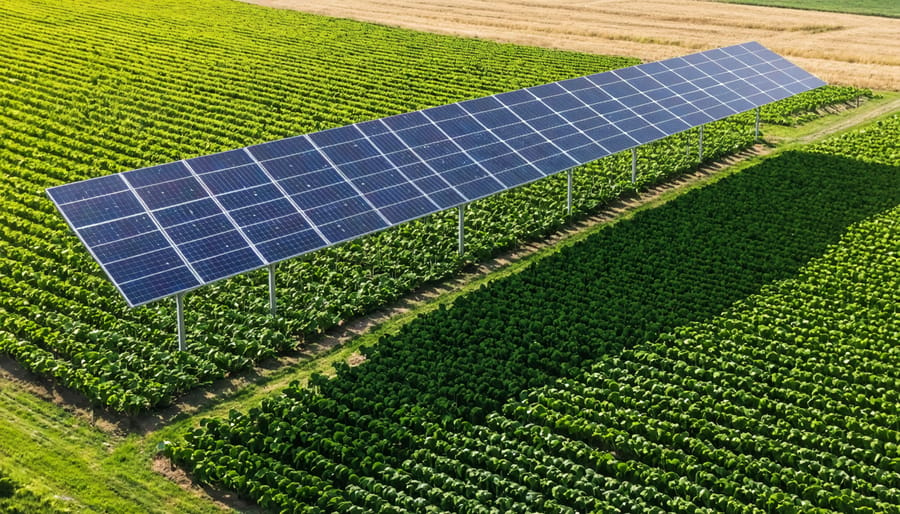Solar microgrids are revolutionizing energy independence for Canadian farmers, offering a powerful solution to rising electricity costs and grid reliability challenges. Across Alberta’s agricultural landscape, these localized power systems combine solar panels, smart controllers, and battery storage to create self-sustaining energy networks that keep farms running efficiently even during grid outages.
For Alberta’s farming community, solar microgrids represent more than just an alternative power source – they’re a strategic investment in operational resilience. Modern agricultural operations, from dairy farms requiring constant refrigeration to automated irrigation systems, demand consistent, reliable power. These systems deliver precisely that, while reducing energy costs by 30-50% for many farming operations.
Recent implementations at the Henderson Valley Dairy Farm near Red Deer showcase how solar microgrids maintain critical operations during extreme weather events, protecting livestock and preserving produce when traditional power systems fail. This technology isn’t just about keeping the lights on – it’s about securing the future of Canadian agriculture through sustainable, reliable energy solutions that make economic sense for farmers.
These self-contained power systems are proving particularly valuable in Alberta’s remote farming regions, where grid connections can be both expensive and unreliable. By generating and storing their own clean energy, farms are gaining true energy independence while contributing to Canada’s climate goals.
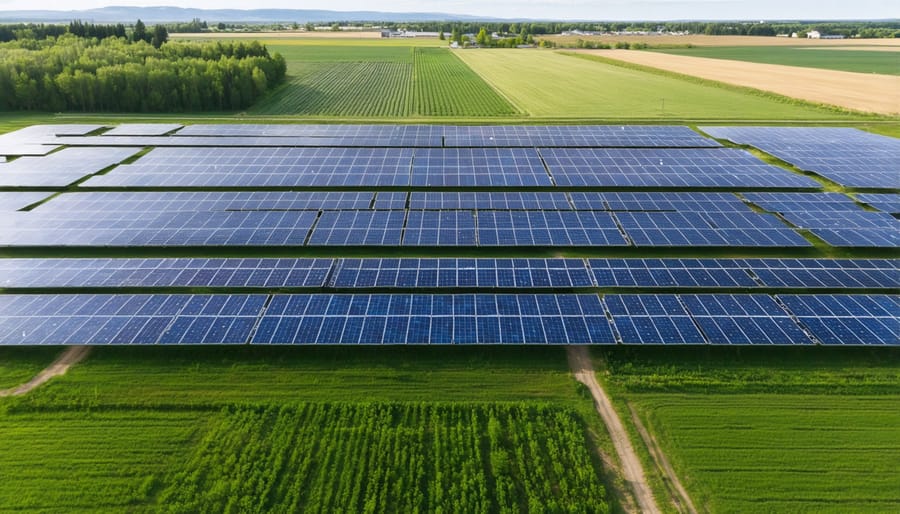
Why Alberta Farms Need Solar Microgrids Now
Energy Independence in Rural Alberta
For Alberta’s farming communities, energy independence isn’t just about saving money – it’s about securing our agricultural future. Solar microgrids are transforming how rural properties manage their power needs, offering freedom from grid vulnerabilities and unpredictable energy costs.
Take the Thompson family farm near Red Deer, who installed their microgrid system in 2021. “We haven’t worried about power outages since installation, even during the harshest winter storms,” shares Sarah Thompson. Their 15-kilowatt system powers their entire dairy operation, including crucial milk storage facilities.
These independent power systems are particularly valuable during Alberta’s extreme weather events, when traditional power lines may fail. With battery storage capabilities, farms can maintain critical operations like irrigation systems and climate-controlled buildings around the clock.
Local energy cooperatives are emerging across rural Alberta, with neighboring farms sharing resources and backup power through connected microgrids. This community-based approach not only enhances energy security but also builds resilience within our agricultural sector.
By generating their own clean energy, Alberta farmers are taking control of their operational costs while contributing to environmental sustainability – a win-win for agriculture’s future.
Cost Savings Beyond the Power Bill
The financial benefits of solar microgrids extend well beyond monthly power savings. Through Alberta solar incentives and federal clean energy programs, farmers can recover up to 40% of their initial installation costs. These incentives, combined with accelerated depreciation allowances, make the investment considerably more attractive.
Long-term benefits include protection against rising utility rates, which have increased by an average of 3.2% annually in Alberta over the past decade. Many farmers report achieving complete return on investment within 7-9 years, significantly shorter than the 25-30 year lifespan of most solar installations.
Additional savings come from reduced maintenance costs for traditional power infrastructure and decreased reliance on backup generators. Some agricultural operations have also found new revenue streams by selling excess power back to the grid during peak production periods. Insurance companies are beginning to offer premium reductions for farms with microgrids, recognizing their increased resilience to power outages and natural disasters.
Building Your Farm’s Solar Microgrid
Essential Components and Setup
A solar microgrid system for your farm requires several key components working together seamlessly. The foundation starts with a robust solar panel installation sized appropriately for your farm’s energy needs. Here in Alberta, we typically recommend ground-mounted arrays for easier maintenance, though roof installations can work well for smaller operations.
Reliable battery storage systems are essential for maintaining power during nighttime and cloudy periods. Most Alberta farmers find success with lithium-ion batteries, which perform well in our climate and offer excellent longevity. For an average 160-acre operation, a 40-50 kWh storage capacity usually provides sufficient backup.
The system also requires an inverter to convert DC power from your panels to AC power for farm equipment, plus a charge controller to manage battery charging. A smart control system helps monitor and optimize energy flow, while protective equipment like circuit breakers and surge protectors ensure safe operation.
Connection infrastructure includes proper wiring, mounting hardware, and weather-resistant enclosures suited to our prairie conditions. Don’t forget about metering equipment – it’s crucial for tracking your system’s performance and managing power distribution across different farm operations.
Many local suppliers can help you source these components, and several Alberta-based installers specialize in agricultural applications. Remember, proper sizing and quality components are key to building a system that’ll serve your farm reliably for years to come.

Sizing Your System Right
Determining the right size for your solar microgrid starts with a thorough assessment of your farm energy consumption. Most Alberta farms require between 30-75 kWh per day, but this can vary significantly based on operations and seasonal demands.
To accurately size your system, start by reviewing your past 12 months of electricity bills. Pay special attention to peak usage periods, typically during irrigation season or harvest time. For every 10 kilowatts of system capacity needed, plan for approximately 40-50 square meters of solar panel space.
A practical approach is to follow the “80/20 rule” – design your system to handle 80% of your peak load, as oversizing can lead to unnecessary costs. Consider starting with a smaller system that can be expanded later, especially if you’re new to solar technology.
Key factors to evaluate include:
– Daily energy requirements
– Available roof or ground space
– Budget constraints
– Future expansion plans
– Seasonal load variations
For example, a mid-sized dairy operation in Red Deer successfully implemented a 50kW system that covers 75% of their annual energy needs, with battery storage capacity for 36 hours of operation. Working with a certified solar installer can help fine-tune these calculations for your specific situation and ensure your investment matches your farm’s unique needs.
Integration with Existing Farm Operations
Integrating a solar microgrid into your existing farm operation doesn’t have to be disruptive. Many Alberta farmers have successfully incorporated these systems while maintaining their regular farming activities. The key is strategic placement and phased implementation.
Start by identifying your farm’s high-energy-use areas and peak consumption times. Common integration points include irrigation systems, grain drying facilities, and dairy operations. For example, the Johnson family farm near Lethbridge successfully integrated their solar microgrid with their centre pivot irrigation system, reducing their energy costs by 40% in the first year.
Consider your available space carefully. Solar panels can be mounted on existing building rooftops, installed on unused land, or even integrated into grazing areas through elevated mounting systems that allow livestock to pass underneath. Many Alberta farmers have found that south-facing slopes or areas with poor soil quality make ideal locations for solar installations.
Your existing electrical infrastructure will need assessment by qualified professionals to ensure compatibility. Most farms require minimal modifications to their current systems, typically focusing on updating the main electrical panel and installing proper safety disconnects.
Working with local contractors who understand both agricultural operations and renewable energy systems is crucial. They can help schedule installation during off-peak farming seasons and ensure minimal disruption to your daily operations. Remember to maintain clear access routes to all farming equipment and facilities during and after installation.
The Alberta Farm Solar Program has demonstrated that farms can typically maintain full operations throughout the integration process, with most installations completed within 2-3 weeks.
Real Success Stories: Alberta Farms Using Solar Microgrids
Davidson Family Farm’s Energy Revolution
Located just outside of Leduc, Alberta, the Davidson Family Farm’s transition to solar microgrid technology in 2021 has become a shining example of agricultural innovation. The 300-hectare dairy operation, run by third-generation farmers Jack and Sarah Davidson, faced mounting energy costs that were eating into their profit margins.
“Our monthly electricity bills were approaching $4,500, and we knew something had to change,” explains Jack Davidson. Working with local renewable energy experts, the Davidsons installed a 75kW solar array combined with a 100kWh battery storage system, creating a self-sustaining microgrid.
The system powers their entire milking operation, including the automated milking machines, milk cooling system, and barn climate controls. During peak sunlight hours, excess energy is stored in batteries for use during nighttime operations or cloudy days. The farm remains connected to the main power grid but only draws from it during extended periods of low solar production.
The results have been remarkable. The Davidsons report an 85% reduction in their electricity costs, with the system expected to pay for itself within 6 years. More importantly, the farm now operates with minimal interruption, even during regional power outages. “Last winter’s ice storm knocked out power in our area for three days, but our cows were milked right on schedule,” Sarah proudly notes.
The success has inspired neighbouring farms to explore similar solutions, creating a growing network of climate-smart dairy operations in central Alberta.
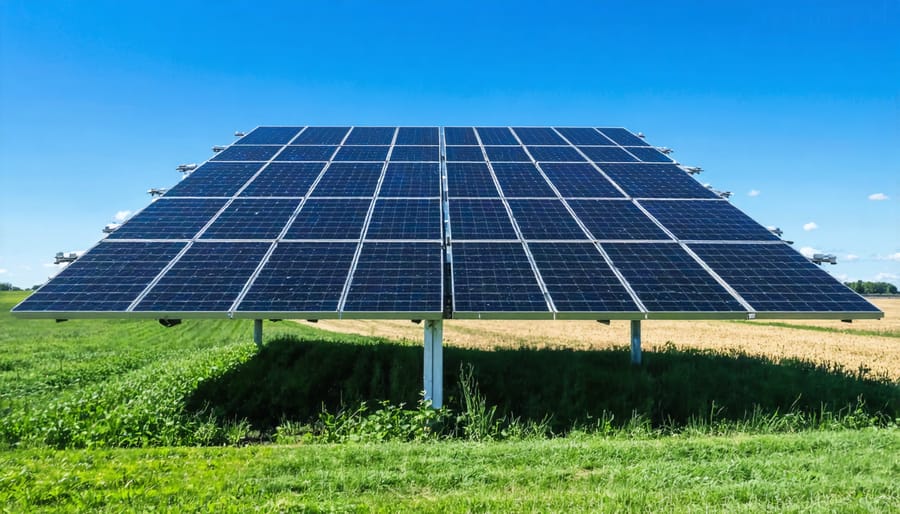
Green Acres Greenhouse: Year-Round Power Security
Located just outside of Lethbridge, Alberta, Green Acres Greenhouse has transformed their year-round growing operation through the implementation of a solar microgrid system. Owner Sarah Thompson made the switch in 2021 after experiencing multiple power disruptions that threatened her delicate hydroponic lettuce crops.
“We couldn’t afford to lose power for even a few hours during winter,” Thompson explains. “Our previous backup generator system was costly to maintain and unreliable. The solar microgrid has given us complete energy independence.”
The greenhouse’s 75-kilowatt solar array, combined with a 100-kWh battery storage system, now powers their entire 2,000-square-metre facility. The system maintains optimal growing conditions for their crops throughout Alberta’s challenging weather conditions, from -30°C winters to intense summer heat waves.
The installation has reduced their annual energy costs by 65% and eliminated power-related crop losses. During summer months, excess power generation is fed back into the local grid, providing additional revenue through Alberta’s net metering program.
“What impressed me most was how the system handled last winter’s ice storm,” Thompson notes. “While neighbouring operations lost power for three days, our greenhouse maintained perfect growing conditions. The return on investment has been better than expected, and we’re planning to expand our growing space next year.”
Environmental Impact and Future Benefits
Carbon Footprint Reduction
Solar microgrids offer substantial environmental benefits by significantly reducing farm operations’ carbon footprint. Based on data from Alberta agricultural installations, a typical 100-kilowatt microgrid system can offset approximately 85 tonnes of CO2 emissions annually – equivalent to taking 18 cars off the road.
For a mid-sized dairy farm in Central Alberta, implementing a solar microgrid has resulted in a 40% reduction in grid electricity consumption, translating to roughly 60 tonnes of avoided carbon emissions per year. These environmental gains extend beyond direct energy usage, as microgrids enable farms to power electric farm equipment and irrigation systems with clean energy.
The cumulative impact is particularly noteworthy when considering seasonal operations. During peak summer months, when irrigation demands are highest, solar microgrids can provide up to 80% of a farm’s daily energy needs, dramatically reducing reliance on carbon-intensive grid power. Several Alberta farms have reported achieving carbon-neutral status during summer operations through strategic microgrid deployment combined with energy storage solutions.
Moreover, these systems help farms meet increasingly stringent environmental regulations while positioning them favorably for carbon credit programs and sustainable agriculture certifications.
Future-Proofing Your Farm
Investing in a solar microgrid today positions your farm for the opportunities of tomorrow. As renewable energy technology continues to advance, your existing system can be expanded to accommodate new innovations like advanced battery storage systems and smart farm equipment. Many Alberta farmers are already planning for additional solar panels to support future electric tractors and harvesting machinery.
The modular nature of microgrids means you can scale up gradually as your farm’s energy needs grow. Whether you’re considering adding new buildings, irrigation systems, or processing facilities, your microgrid can expand alongside your operations. This flexibility helps protect your initial investment while providing a foundation for future growth.
Beyond equipment upgrades, solar microgrids open doors to new revenue streams. Some farmers in Alberta are already exploring opportunities to sell excess power back to the grid or participate in virtual power plant programs. Others are using their renewable energy credentials to access premium markets and sustainable agriculture certifications.
By embracing solar technology now, you’re not just solving today’s energy challenges – you’re building resilience for generations to come.
Solar microgrids represent a transformative opportunity for Canadian farmers to take control of their energy future while contributing to sustainable agriculture. Throughout this article, we’ve explored how these systems can significantly reduce operational costs, enhance farm resilience, and provide energy independence – all while supporting our national climate goals.
For Alberta farmers considering this investment, the path forward is clear and well-supported. With current government incentives, proven success stories across the province, and a growing network of qualified installers, there’s never been a better time to explore solar microgrid implementation.
Take the first step by conducting an energy audit of your farm operations and consulting with local solar providers who understand agricultural needs. Connect with neighbouring farmers who have already made the transition – their experiences and insights are invaluable resources. Remember that your local agricultural extension office can provide additional guidance and connect you with funding opportunities.
The future of farming is evolving, and solar microgrids are becoming an essential part of modern agricultural infrastructure. By embracing this technology, you’re not just investing in your farm’s future – you’re joining a community of forward-thinking agricultural leaders who are shaping sustainable farming practices for generations to come.
Ready to get started? Reach out to your local renewable energy association or agricultural cooperative. Together, we can build a more sustainable and energy-independent farming future for Alberta.

